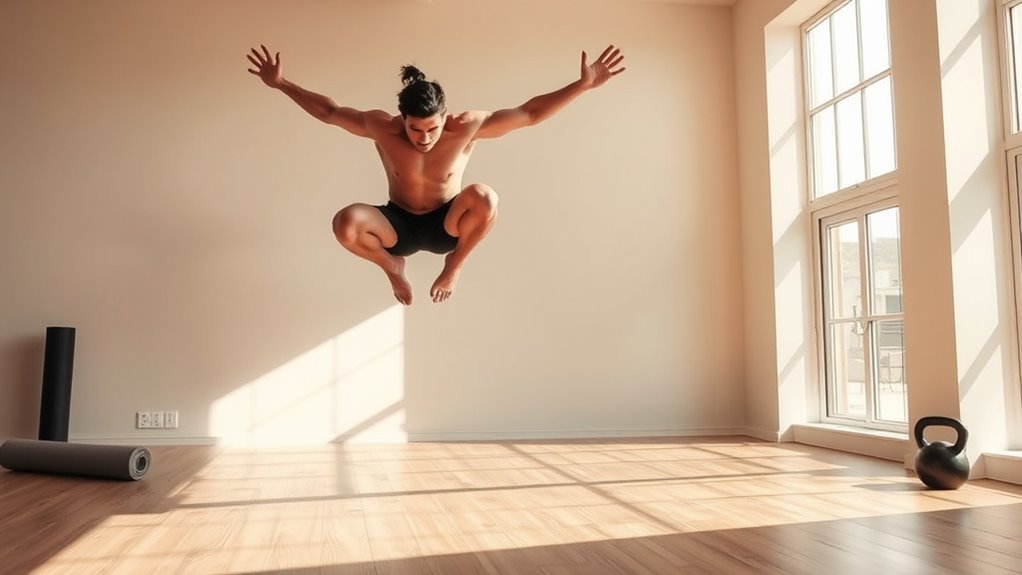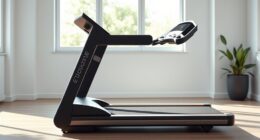You can do primal movement workouts at home using your body weight by practicing squats, lunges, push-ups, and crawling exercises that mimic natural patterns. All you need is a clear, obstacle-free space and some minimal equipment like resistance bands or a sturdy chair. Focus on proper form and gentle progressions to build strength, mobility, and coordination. Keep exploring to discover effective routines and tips to stay consistent with your primal fitness journey.
Key Takeaways
- Incorporate bodyweight exercises like squats, lunges, push-ups, and planks for effective primal movement training at home.
- Use minimal equipment such as resistance bands or household items to increase challenge and variety.
- Create a 6×6-foot obstacle-free space with proper flooring, ventilation, and lighting for safe practice.
- Follow structured routines including warm-up, dynamic movements, and cool-down stretches to maximize benefits.
- Progress gradually by adding variations, increasing reps, or integrating animal-inspired movements to enhance strength and coordination.
Understanding the Foundations of Primal Movement
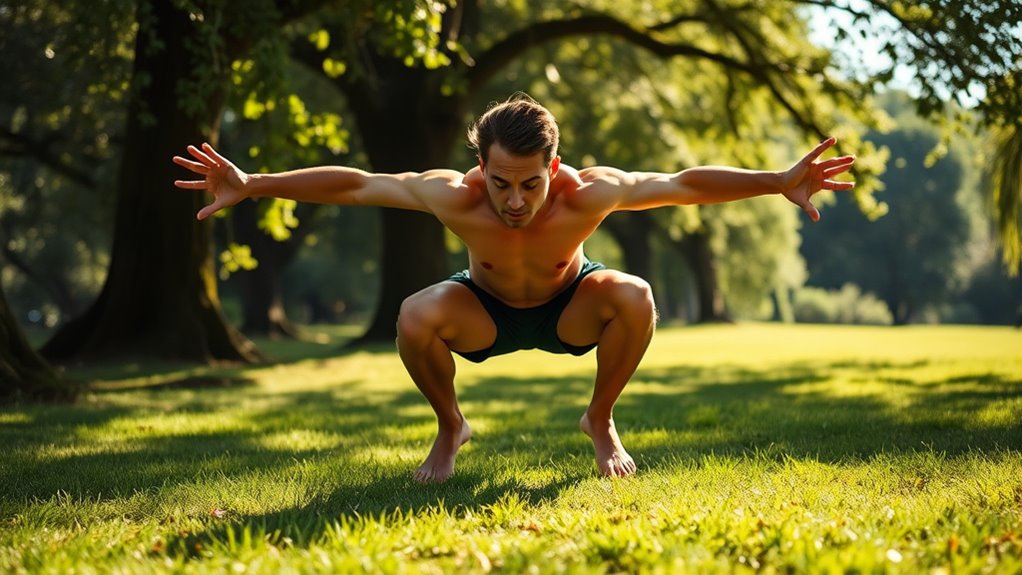
What are primal movements, and why do they matter? Primal movements are the natural, fundamental patterns that all humans perform. These include actions like squatting, hinging, walking, reaching, carrying, running, standing, and resting. They align with the body’s design, promoting strength and health through functional motion. These movements form the foundation for more complex activities, making daily tasks easier and safer. There are seven primary patterns—pushing, pulling, gait, hinge, squat, rotation, and weight shift—that develop our ability to move efficiently. Practicing primal movements improves coordination, stability, and mobility while reducing injury risk. They also enhance overall strength and body awareness. Recognizing the importance of movement efficiency can lead to better performance and injury prevention. Incorporating these basic patterns into your routine can also boost body awareness and help prevent common injuries caused by improper movement. Developing proficiency in primal movements can also support functional fitness, making real-life activities easier and safer.
Essential Equipment and Space for Home Practice
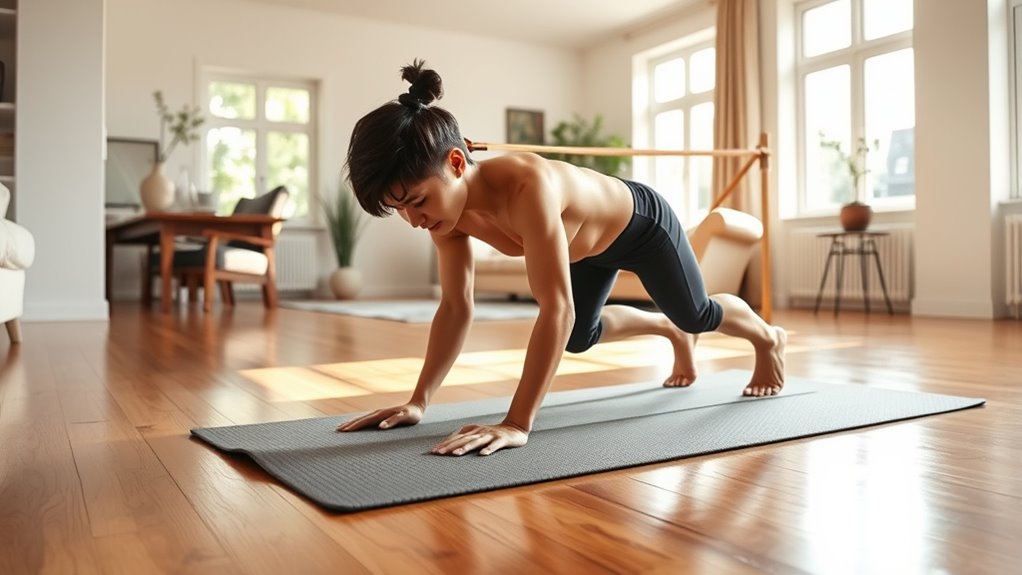
To practice primal movements effectively at home, having the right equipment and space makes a significant difference. You can start with bodyweight exercises like squats, lunges, push-ups, and planks, which need no equipment. Adding a kettlebell or dumbbells offers versatile loading options for progression, while resistance bands are compact and adaptable. A sturdy pull-up bar installed in a doorway can target your upper body strength. For space, guarantee you have a clear, obstacle-free area about 6×6 feet for safe movement, preferably with a cushioned floor or mat to absorb impact. High ceilings—at least 8 feet—are important for jumping or overhead movements. Outdoor spaces like yards or driveways can extend your workout area, providing fresh air and natural terrain. Using appropriate workout surfaces can help prevent injuries and improve stability during your primal workouts. Additionally, incorporating suitable flooring can enhance safety and comfort during high-impact movements. Ensuring proper ventilation and airflow within your workout area can help maintain optimal performance and safety. Incorporating proper lighting is also beneficial to ensure visibility and reduce the risk of accidents during exercises.
Designing Your Primal Movement Routine

When designing your primal movement routine, start by establishing a foundation of warm-up and mobility exercises to prepare your body for more dynamic work. Light dynamic stretches and short mobility drills help loosen joints and prime muscles for movement. Focus on proper form and control over speed to prevent injury and build a solid technique. Incorporate basic movements like squats, lunges, pushes, pulls, and hinges, gradually increasing intensity as you gain confidence. Mix animal-inspired exercises like bear crawls and crab walks to boost coordination and balance. Remember to perform exercises in sets with short rest periods, allowing for steady progression. Incorporating functional movement patterns into your routine can enhance your overall mobility and daily activity performance. Additionally, understanding correct equipment use can provide insights into maximizing safety and effectiveness during your workouts. Engaging in mindful movement practices can further improve your awareness and control during workouts. Exploring holistic movement approaches can support a balanced development of strength, flexibility, and coordination. Additionally, understanding Fokos can provide insights into holistic approaches to movement and wellness.
Sample Full-Body Primal Workout Plan

A well-structured full-body primal workout plan offers an effective way to engage multiple movement patterns and improve overall fitness. Begin with a dynamic warm-up, including arm swings and shoulder rotations, to prepare your muscles. Incorporate bodyweight squats and lunges to strengthen your legs and hips. Add crawling and climbing movements to boost upper body strength and coordination. Incorporate jumping and leaping exercises to develop explosive power and agility. Include rotation and twisting movements to enhance core stability and flexibility. Focus on functional strength during your carrying and lifting drills to improve your ability to perform everyday tasks efficiently. To increase your endurance and reduce recovery time, consider incorporating proper nutrition into your routine. Additionally, paying attention to community engagement can motivate you and provide support during your fitness journey. Incorporating rest and recovery strategies is also essential to prevent injuries and promote muscle growth. Finish with carrying and lifting drills to build functional strength. You can also simulate arcade-style high score competitions to motivate yourself and track progress. Aim for a balanced session that combines these movements, focusing on proper form and controlled effort. This approach maximizes total body conditioning, making your workout versatile and accessible, even without equipment.
Progressing and Scaling Your Movements
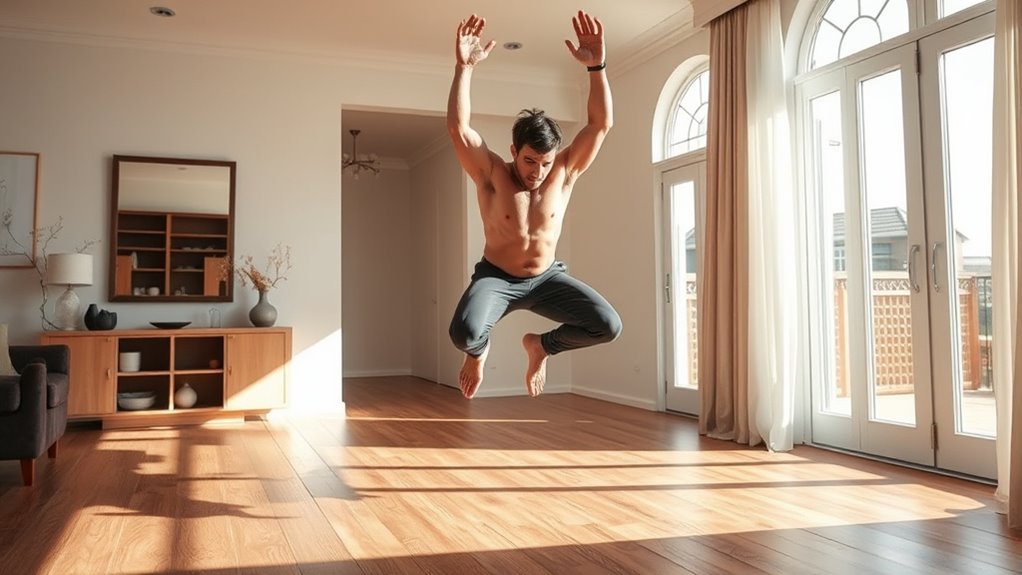
Understanding how to progress and scale your primal movements is essential for continuous improvement and safe training. You want to challenge your body gradually, starting with basic exercises like squats or lunges, then adding difficulty through variations or weight. Focus on building a solid foundation before increasing intensity. Incorporate different types of squats or lunges to keep things fresh and target muscles differently. Proper form is vital—never sacrifice technique for more reps or added weight. Use minimal equipment, like resistance bands, to modify exercises, or increase reps and sets for higher intensity. Adapt movements to your fitness level, ensuring you’re not overwhelmed or risking injury. Regularly reviewing your progress and adjusting your routines can further enhance training effectiveness, as well as preventing plateaus and maintaining motivation. Incorporating mindful practices such as body awareness can help you better understand your physical limits and improve movement quality. Tracking performance metrics like repetition counts or workout duration can also provide valuable feedback on your training progress. Consistently adjusting and scaling your workouts helps you stay motivated and makes progress sustainable.
Incorporating Animal Flow Into Daily Workouts

Incorporating Animal Flow into your daily workouts is an effective way to enhance strength, flexibility, and mobility using just your bodyweight. Start by warming up with wrist mobilizations to prepare your joints and prevent injury. Use static activations to engage muscles and increase body awareness before moving into dynamic traveling forms and progressions. These sequences build strength, coordination, and agility, translating into better daily movement. Incorporate form-specific stretches to boost flexibility and stability. Finish with flowing movements that combine multiple positions into smooth, continuous sequences, improving overall functional fitness. Since Animal Flow requires no equipment, it’s perfect for home practice. Consistent practice helps boost endurance, joint mobility, and muscular control, making everyday movements safer and more efficient. Additionally, integrating sound healing science principles, such as mindful breathing and vibrational techniques, can further enhance your body awareness and recovery during these workouts. Incorporating holistic health approaches can help optimize your overall well-being and support your fitness journey effectively, especially when you consider the importance of proper recovery strategies for sustained progress. Exploring mindfulness practices within your routine can also improve focus and mental clarity, complementing your physical training.
Benefits of Primal Movement for Functional Fitness
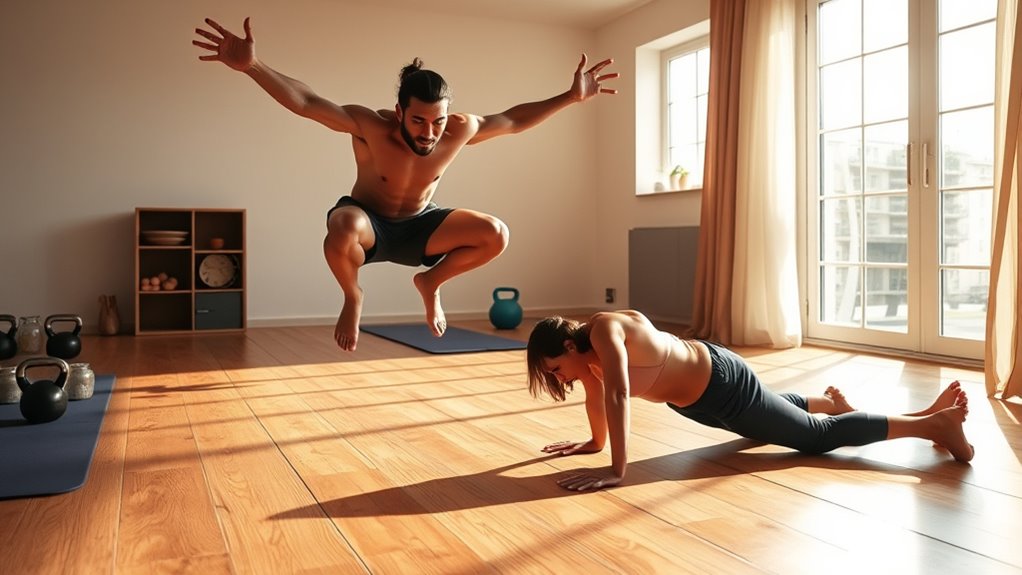
Primal movement enhances your functional fitness by engaging multiple muscle groups simultaneously, which boosts overall strength and coordination. These movements mimic daily-life patterns, preparing your body for real-world physical challenges. Unlike traditional isolation exercises, primal movements incorporate compound actions across different planes of motion, improving neuromuscular control. They also enhance coordination, balance, and body awareness, giving you greater confidence in everyday activities. Regular practice increases mobility and flexibility, supporting joint health and reducing injury risk. These dynamic movements counteract stiffness from sedentary habits, promoting better posture and alignment. Additionally, primal workouts build core strength and stability, essential for maintaining balance. The full-body engagement elevates calorie burn and muscular endurance, supporting weight management and cardiovascular health. Overall, primal movement develops a holistic, adaptable fitness foundation for daily life.
Tips for Maintaining Consistency and Motivation
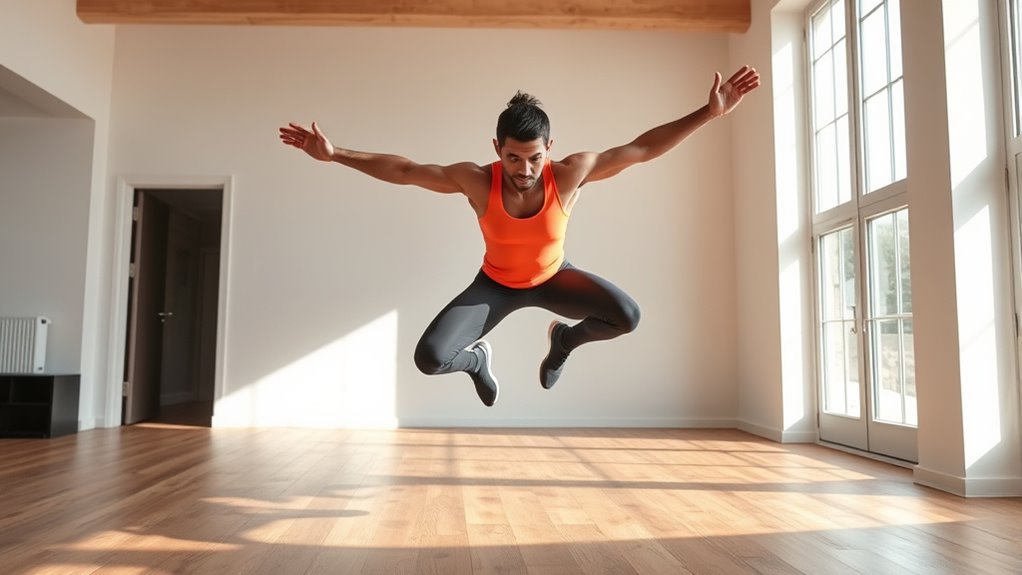
Maintaining consistency and motivation with primal movement workouts requires intentional planning and mindful effort. Schedule your sessions regularly—aim for three to five times a week—and set specific times to create a predictable routine. Use calendar apps or reminders to bolster accountability and prevent skipping workouts. Incorporate primal movements into your warm-up or full workout to guarantee frequent practice. Focus on proper form and controlled repetitions rather than speed to maximize effectiveness and reduce injury risk. Break larger goals into smaller milestones, celebrating each achievement to stay motivated. Vary your routines to keep things interesting and progressively increase difficulty. Tracking your progress through logs or videos helps you see improvements and stay committed. Engaging with communities or seeking feedback further reinforces your dedication.
Modifications for Different Fitness Levels
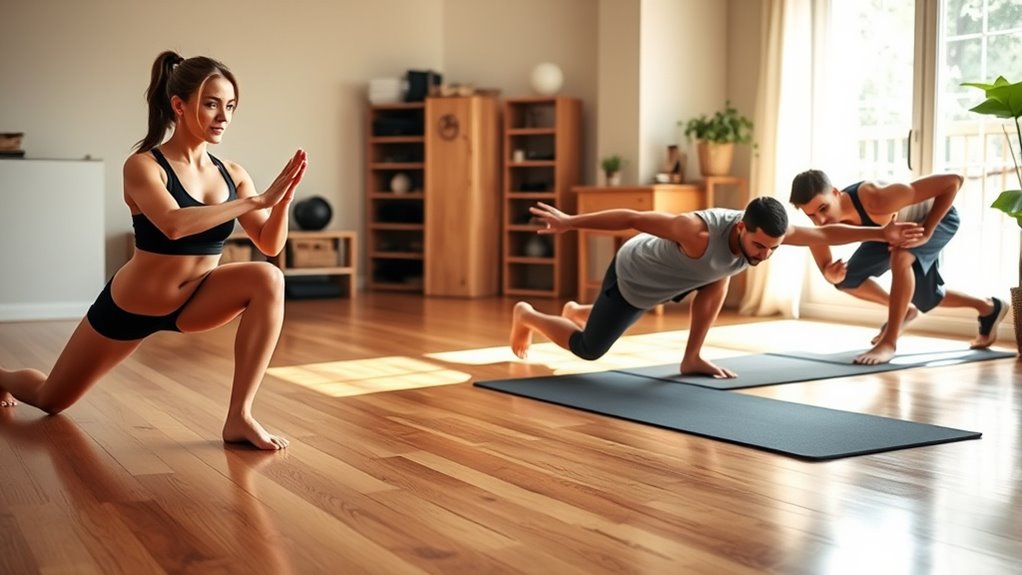
Adjusting primal movement workouts to suit different fitness levels guarantees safe progress and continued challenge. If you’re a beginner, start with foundational patterns, using slower tempos and limited range to build control and confidence. Support yourself with stable surfaces like chairs or counters, and reduce the depth of lunges or squats to make movements easier. As you gain strength, increase repetitions or hold positions longer, and gradually remove supports to boost stability. For more advanced practitioners, incorporate dynamic elements like jumping, add external resistance, or perform complex multi-planar movements. Modifying range of motion and balance challenges helps ensure you’re exercising safely while progressing at your own pace. These tweaks keep your workouts effective, engaging, and tailored to your evolving fitness level.
Resources and Guidance for Advanced Practice
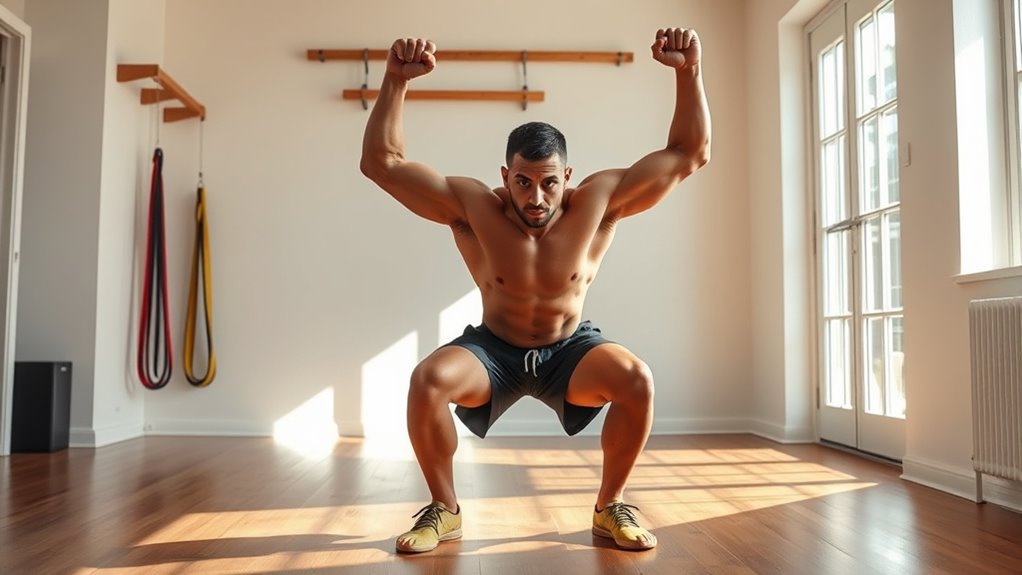
For advanced practitioners seeking to elevate their primal movement practice, a wealth of online resources and guidance are readily available to support ongoing development. You’ll find numerous YouTube playlists and videos dedicated to complex primal workouts, offering detailed warm-ups, multiple progression rounds, and cooldown routines. Follow-along videos help you maintain proper form and pacing without a coach, while online communities provide tips, challenges, and motivation. To deepen your skills, explore tutorials on advanced moves like shrimp squats, pistol squats, and rotational ground work. Many creators combine primal movements with strength and mobility training, enhancing athleticism. Supplement your practice with downloadable guides and instructional materials from various platforms, ensuring consistent progress while minimizing injury risks. These resources empower you to refine your skills and push your limits at home or outdoors.
Frequently Asked Questions
Can Primal Movement Exercises Help With Chronic Joint Pain?
Yes, primal movement exercises can help with chronic joint pain. You’ll strengthen muscles around your joints, which supports and stabilizes them, reducing discomfort. These exercises also improve your joint mobility and decrease inflammation, making daily movements easier. Plus, they help maintain muscle mass as you age, lowering the risk of further pain. Just make certain you focus on proper form and consult a specialist if needed, to avoid injuries.
How Do I Prevent Injury During Animal Flow Movements?
To prevent injury during animal flow movements, focus on forming a firm foundation. Start with a thorough warm-up to awaken muscles and mobilize joints. Maintain mindful movement, mastering proper posture and pacing. Practice controlled, consistent techniques, and incorporate correct breathing to build body balance. Listen to your body, and don’t push beyond limits. Seek expert guidance, and gradually grow stronger, ensuring safety stays steady on your movement journey.
Are Primal Workouts Suitable for Elderly or Mobility-Impaired Individuals?
You might wonder if primal workouts suit elderly or mobility-impaired individuals. They can, when properly adapted, helping you build strength, improve balance, and increase joint mobility. Focus on slow, controlled movements and modify intensity to match your ability. Always prioritize proper form and consider guidance from healthcare providers or trainers. These exercises promote confidence and independence, but safety and personalization are key to making them beneficial and enjoyable for you.
What Are the Signs of Overtraining in Primal Movement Routines?
Like a fire blazing too bright, overtraining shows signs you can’t ignore. You might feel muscle soreness lasting over 72 hours, or notice your performance stalls despite effort. Premature fatigue, injuries, and overheating signal your body’s warning. Mentally, you could feel irritable, unmotivated, or distracted. If recovery takes longer than usual and soreness persists, you’re pushing too hard. Pay attention, back off, and give your body the rest it needs to heal and grow stronger.
How Long Before I Notice Improvements in Strength and Mobility?
You’ll likely notice initial strength and mobility improvements within 2-4 weeks, thanks to neural adaptations. By around 4-6 weeks, you’ll see more visible gains in muscle strength and joint flexibility. Consistency, proper technique, and gradual progression speed up results. Keep in mind, full benefits usually develop after 6-8 weeks of regular training, with long-term improvements in posture, balance, and overall functional fitness becoming evident over time.
Conclusion
Embrace primal movement to build strength, enhance mobility, and boost your overall well-being. Move mindfully, challenge yourself, and stay consistent in your practice. Listen to your body, progress gradually, and enjoy the journey. With dedication and curiosity, you’ll release your body’s natural potential. Remember, every step forward is a step toward better health. Keep moving, keep improving, and let primal movement transform your home workout experience.
